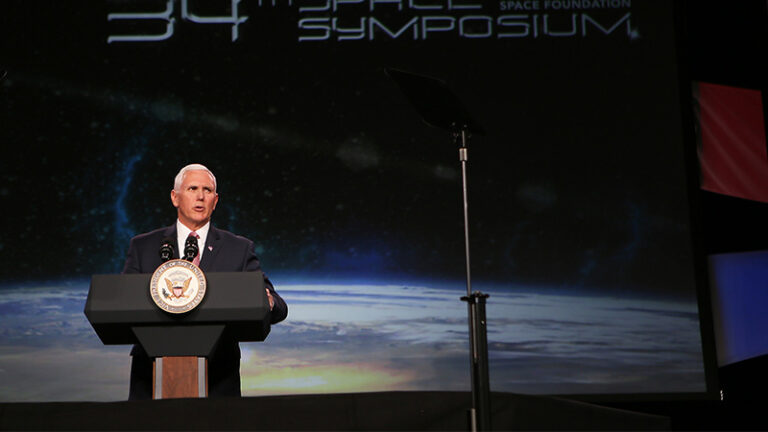Stay Up to Date
Submit your email address to receive the latest industry and Aerospace America news.
COLORADO SPRINGS, Colo. — The U.S. National Space Council is readying a space-traffic-management policy recommendation for President Donald Trump that will “address the challenges posed by our increasingly congested space environment,” said Vice President Mike Pence, speaking Monday in opening remarks at the 34th Space Symposium in Colorado Springs, Colo.
“At this very moment, as many in this room understand, there are tens of thousands of manmade objects orbiting the Earth, including more than 1,500 active satellites and thousands of inactive satellites and spacecraft fragments,” Pence said at the Space Foundation’s annual event.
“And as commercial companies continue to send even more satellites into orbit, the volume of space traffic will only increase. In low Earth orbit, objects travel as fast as 4.3 miles per second, which means collisions can scatter thousands of spacecraft remnants across the orbital environment.”
Referring to the 2009 collision between an Iridium communications satellite and an inactive Russian satellite, Pence said:
“President Trump knows that a stable and orderly space environment is critical to the strength of our economy and the resilience of our national security systems. That’s why the National Space Council has developed the first comprehensive space traffic management policy we’ll be sending to the president’s desk for his approval.”
Pence also announced that retired U.S. Navy Adm. Jim Ellis, a director emeritus of the Space Foundation and a former commander of U.S. Strategic Command, will chair the National Space Council’s Users Advisory Group, a collection of corporate CEOs, scholars and space advocates. He underscored what he said was the administration’s determination to invest in research to help commercial space companies build “the orbital platforms of the future, where the government will be a tenant and a customer — and not the landlord.”
Shortly after taking office, Trump re-established the National Space Council, which had been defunct since 1993, and assigned Pence to chair it. Trump signed Space Policy Directive-1 into effect in December; the document asserts that “the United States will lead the return of humans to the Moon for long-term exploration and utilization, followed by human missions to Mars and other destinations.”
The White House in March announced an “America First” strategy for space that prioritizes private-sector partnerships, U.S. leadership and defense. The “National Space Strategy” came out not long after the president made news by floating the idea of creating a “Space Force” as a separate branch of the military. The idea of a “Space Corps” within the Air Force was already destined for a think tank review as of late March.
NASA now plans to build a U.S. space station called the Lunar Orbital Platform-Gateway by 2025 as a base from which to launch missions to the moon’s surface. Formerly known as Deep Space Gateway, when Mars was the main target, the conceptual station got its new name in the Trump administration’s fiscal 2019 budget request. Five companies are working on ideas for the station’s power and propulsion element. Meanwhile, NASA has asked industry for information about lunar landers.
NASA’s Bill Gerstenmaier, associate administrator for human exploration and operations, told Aerospace America in March that building the moon lander will delay construction of a spaceship to fly people to Mars orbit.
Exploring the red planet was an emphasis of the Obama administration.
U.S. Vice President Mike Pence speaks at the Space Symposium on Monday in the Space Foundation photo at top.
https://aerospaceamerica.aiaa.org/features/preventing-space-pollution/
"President Trump knows that a stable and orderly space environment is critical to the strength of our economy and the resilience of our national security systems. That’s why the National Space Council has developed the first comprehensive space traffic management policy we’ll be sending to the president’s desk for his approval.”
U.S. Vice President Mike Pence
About Amanda Miller
Amanda is a freelance reporter and editor based near Denver with 20 years of experience at weekly and daily publications.
Related Posts
Stay Up to Date
Submit your email address to receive the latest industry and Aerospace America news.




